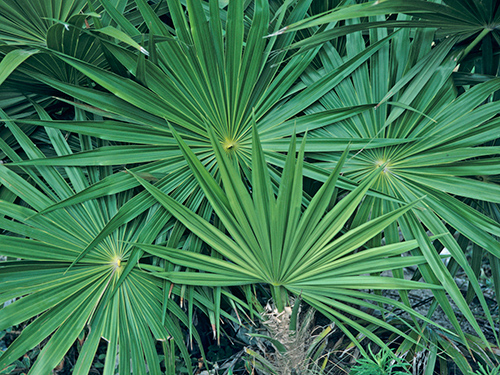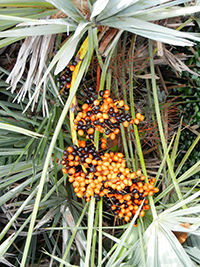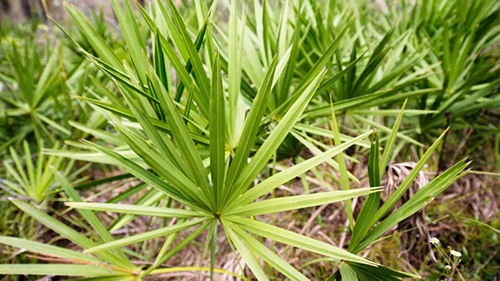Contents
The palmetto shrub is a small American palm. Its fruit resembles small dates and has been consumed for a long time in Georgia, Florida, Louisiana, and other states of southeastern America. Ancient native inhabitants of the region already knew the fruit’s medicinal properties and even used it as an aphrodisiac. Recently, some fascinating active components have been discovered in the fruit, part of several pharmaceutical preparations.

Palmetto Shrub Scientific Facts
- Scientific synonyms: Sabal serrulata Schult.
- Other names: Saw palmetto.
- French: Serenoa.
- Spanish: Sabal, serenoa, palmerita.
- Environment: Sandy soils and coastal regions of the southwestern United States, especially Florida. It also grows in some Central American areas.
- Description: Palm of the Palmaceae family, growing up to 3 m high, with ivory-colored flowers. The fruit is date-like, around 2 cm long, blackish when ripe.
- Parts of the plant used medicinally: The fruit when ripe.

Healing Properties and Indications
After being dissolved in a fatty environment, the fatty extract obtained from the fruit of the palmetto shrub contains several phytosterols, especially beta-sitosterol, a triterpenic alcohol (cycloartenol), and fatty aliphatic alcohols of high molecular weight. All of them have anti-inflammatory properties on the prostate. Their hormonal action mechanism prevents the proliferation of androgens in prostate tissues.
- Prostate. The use of saw palmetto is helpful for prostatic hypertrophy or adenoma. It stops prostate gland enlargement and notably reduces the significant discomforts of the prostatic syndrome: dysuria (difficulty to urinate), pollakiuria (urge to urinate often), and vesicle tenesmus (permanent sensation of desire to urinate). It is also recommended for prostatitis, both acute and chronic.
- Diuretic. Besides its antiprostatic properties, this plant mildly promotes diuresis. It also has mild pectoral properties.
Saw Palmetto Berries
The saw palmetto plant’s berries benefit bronchitis, asthma, and colds. They are excellent for head and nose congestion, whooping cough, and all throat ailments. A tea made from dried berries effectively treats catarrhal problems and mucous congestion. It is a urinary antiseptic and diuretic. Tea is also a general tonic that aids in building strength during recovery from illness.
Saw palmetto can treat male and female diseases of the reproductive organs. It helps to promote quicker recovery from glandular disorders. The herb can also inhibit the production of dihydrotestosterone, which is a form of testosterone that contributes to prostate enlargement. Steep one teaspoon of dried berries in one cup of water and take one to two cups daily.

How to use Palmetto
- Ripe fresh fruit. An amount of 50-100 g per day can be consumed.
- Decoction
- Extracts
Infusion: Steep for five to fifteen minutes and take six ounces two to three times daily. Tincture: Take fifteen to sixteen drops two to three times daily. Fluid Extract: Take ten drops two to three times daily. Powder: Take two to four #0 capsules (10 to 20 grains) two to three times daily.
DISCLAIMER: All content on this website is presented solely for educational and informational objectives. Do not rely on the information provided as a replacement for advice, diagnosis, or treatment from a qualified medical expert. If you are pregnant, nursing, or have any preexisting medical concerns, talk to your doctor before using any herbal or natural medicines.
REFERENCES
- George D. Pamplona-Roger, M.D. “Encyclopedia of Medicinal Plants.” George D. Pamplona-Roger, M.D. Encyclopedia of Medicinal Plants. Ed. Francesc X. Gelabert. vols. 2 San Fernando de Henares: Editorial Safeliz, 2000. 610. Print. [palmetto shrub]
- Vance Ferrell Harold M. Cherne, M.D. The Natural Remedies Encyclopedia [Book]. – Altamont, TN: Harvestime Books, 2010. – Vol. Seventh Edition: 7: pp. 179.
